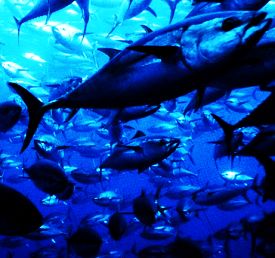Illegal fishing practices in the Philippines and Papua New Guinea may cost the economies of these two impoverished countries dearly. The European Union is reportedly threatening to ban fish imports from the two countries unless they curb illegal fishing practices.
The warning, which was welcomed by environmental groups, puts the two countries on the EU’s “yellow list”, which requires them to improve monitoring and control of fishing practices.
Failure to do so will put them onto the “red list” of nations which are not allowed to sell fish to the 28-nation EU.
“If half of the Western Pacific’s tuna is exported to the EU, we cannot ignore illegal fishing activities in this region,” European Commissioner for Maritime Affairs and Fisheries Maria Damanaki said in a statement.
 Illegal, unreported and unregulated (IUU) fishing usually has a significant impact on the sustainability of both the targeted species and the ecosystem. Fishing generally has the capacity to damage fragile marine ecosystems and vulnerable species such as coral reefs, turtles and seabirds. In fact, all eight sea turtle species are now endangered, and illegal fishing and hunting are two major reasons for their destruction. Regulating legitimate fisheries is aimed at mitigating such impacts, but IUU fishers rarely comply with regulations. This is likely to reduce productivity and biodiversity and create imbalances in the ecosystem.
Illegal, unreported and unregulated (IUU) fishing usually has a significant impact on the sustainability of both the targeted species and the ecosystem. Fishing generally has the capacity to damage fragile marine ecosystems and vulnerable species such as coral reefs, turtles and seabirds. In fact, all eight sea turtle species are now endangered, and illegal fishing and hunting are two major reasons for their destruction. Regulating legitimate fisheries is aimed at mitigating such impacts, but IUU fishers rarely comply with regulations. This is likely to reduce productivity and biodiversity and create imbalances in the ecosystem.
IUU fishing can also lead to increased pressure on endangered fish species. IUU can directly affect the population of fish species by increasing the number of fish caught within the population in spite of population management efforts by the international community. Indirectly, the substitution (mislabeling) of IUU caught fish for popular, but threatened or endangered species, increases the perceived supply of these species, thus decreasing the price and increasing the demand for the fish species.
| SUPPORT INDEPENDENT SOCIAL COMMENTARY! Subscribe to our Substack community GRP Insider to receive by email our in-depth free weekly newsletter. Subscribe to our Substack newsletter, GRP Insider! Learn more |
Curbing illegal fishing in the Philippines is a big challenge. The seriousness Filipinos apply in undertaking such initiatives is best illustrated by the case of Bien Unido town in Bohol province. The town mayor Nino Rey Boniel had reportedly set up statues of religious icons — including one of the Blessed Virgin Mary and another of the Sto. Nino (the Child Jesus) — underwater near coral reefs.
Looking like an apparition, the Virgin Mary’s image was set on the sea floor, 90 feet deep, beside the wall of a reef. Just a few kilometers away is the statue of the Sto. Nino, standing among a bed of corals.
“We have had zero instances of blasting and cyanide since these religious icons were installed. But the Bien Unido Double Barrier Reef is a huge area. And we need all the help we could get,” said Boniel.
The 14-foot, four-ton statues of the Virgin Mary and the Sto. Nino were submerged two years ago by the Sea Knights, a faith-inspired group of divers, in the municipality’s effort to curb illegal fishing activities in Bien Unido, which sits within the Danajon Double Barrier Reef.
But it will likely take more than a fear of God to deter hardened criminals and starving fishermen. In 2011, container loads of illegally-harvested precious black coral were reportedly seized by the Philippines’ Bureau of Customs. The contraband consisted of “134 bundles, or 21,169 pieces, of “sea fan” black corals and 15 bundles, or 196 kilograms, of ‘sea whip’ black corals,” products that are banned under the Convention on the International Trade in Endangered Species of Wild Fauna and Flora.
The extent of the possible destruction was nothing short of appalling…
With 21,169 black coral pieces recovered, this could mean that the area harvested could be as big as 7,000 hectares, or an area almost twice the size of the city of Manila.
Republic Act 8550, “The Philippine Fisheries Code of 1998”, stipulates that accountability for “monitoring, control and surveillance” to ensure “judicious” and “wise” utilisation of the Philippines’ aquatic resources is on the Department of Environment and Natural Resources (DENR). However, the law also places jurisdiction over municipal waters on their respective local government units.
[NB: Parts of this article were lifted from the Wikipedia.org article “Illegal, unreported and unregulated fishing” in a manner compliant to the terms stipulated in the Creative Commons Attribution-ShareAlike 3.0 Unported License that governs usage of content made available in this site.]
benign0 is the Webmaster of GetRealPhilippines.com.
With what are they going to patrol these reefs? A wooden outrigger boat powered by single-cylinder Chinese engine? Seems like a tall order for someone who is only concerned with lining his pockets with public funds.